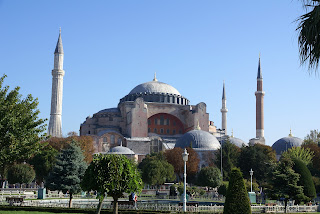This was the largest dome in the world until a cathedral in Seville and St. Peter's in Rome were built in the 16th century AD. The Statue of Liberty will fit inside the dome as will Paris' Notre Dame Cathedral.
These flying buttresses were added several centuries after initial construction to add strength.
The mosaic shown here is over the door from the narthex into the nave. This was the door by which the Emperor entered; no one else was allowed to use it. The mosaic is from the 9th or 10th century and shows the emperor prostrating himself to Jesus Christ.
Above is a huge door; the doorway is between the narthex and the nave. Below is the threshold, showing the results of 1500 years of foot traffic.
We arrived about five minutes after the opening, 0900. Lights were still on in the interior and there were relatively few people inside. It was quiet inside and the quietude added greatly to the experience. You could almost feel the presence of the thousands upon thousands of people who had worshiped here over the centuries. The immenseness of the space and the fact that it was built in the 6th century also added to the awe of the place.
Below is a photo of the interior looking towards the apse. On the left is the Empress' box in which she attended services; it was entered from the gallery. The apse is in the middle with a mosaic of Mary and Jesus high up on the back wall. The large round medallions with what appears to be Arabic writing were added by the Muslims.
The photo above is taken from near the apse looking diagonally towards towards the Emperor's entrance. Below are shown two of the massive pillars supporting the dome.
This is a massive marble jar brought from Pergamon.
Above is the Empress' box. She and her retinue of ladies would attend services in this box.
Below is the dome, photographed from the main floor looking straight up. The last photo is of one of the six winged seraphim or cherubim, I'm not sure which is correct, which are found on the supports of the dome.
I first visited Hagia Sophia in 2009 and wrote about it in a blog entry of Oct 19, 2009. I will write more about it in the next blog entry, Hagia Sophia Redux--Part 2.














No comments:
Post a Comment